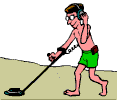|
The first rule for detecting beaches is get to know your beach. Beaches are vast areas and there is never enough time to search the whole beach thoroughly before the tides change. If you live some distance from your nearest beach you may not be able to visit it as often as you would like, therefore you must utilize infrequent visit to the full. If the beach has groynes, take note of the height of the sand against them. Is it higher on one side? Does this change on each visit? If the sand is shallower on one side of the groyne, this is the side you want to detect because you will be getting closer to the old beach. If the sand is very high, you stand little chance of making old finds. The winter is the best time for older finds, as the heavy seas during storms will scour the beach. However, this is not always the case as it sometimes puts more sand on! I only search beaches in the summer when I am on holiday near one and only make visits during the winter after the March winds and April showers. Those however who live close to the beach will search the beach all year round. One tip I have for you is during the day when you visit the beach note where the majority of the people sit. This is the place where you should search for the recent losses such as the coins or even gold rings. Try to detect when the beach is empty and not in use. This way you are not a nuisance to anyone and not a target for annoying little kids! I try to search during the evenings in the areas that I had noted earlier attract more people. In these areas I find many coins, jewelry and the ever-common ring pull. Finds are shallow, so deep seeking machines are not really needed for such areas. Use a trowel for recovery or a sand scoop, and don't leave any holes or junk lying around.
During the winter I always visit the same beach as I've got to know it quite well. I try to find areas where the sand and shingle levels are low where the hardpack may be exposed. Most beaches have a hard surface below the sand and shingle, and this is where the majority of the older finds will be made because coins and artifacts quickly sink down through the upper layers of the beach. Where the hardpack is completely exposed the sea will remove items resting on it, so you have to be quick! Probe the sand and you may find that the hardpack isn't very far below the surface. If so, search slowly and thoroughly until your trowel shows the sand to be too deep. I use a knitting needle for this task and probe in many places because an isolated stone could make all the difference. I have found many pre-decimal coins by using this method on what seem to be modern beaches. When the sea removes sand and shingle from the beach it tends to take light finds with it such as silver paper. I therefore avoid areas where I find these even if modern coins are coming up as well because I'm after the older items! If you know of a beach where shipwrecks are known, search these beaches thoroughly after any storms.
The high levels of salt on beaches make them difficult to work when wet, as the beach then becomes conductive to your machine, which reacts as if you have a signal. I therefore prefer to use a VLF/TR machine with auto-tune on a wet beach and search in TR discriminate only. The after ring on auto-tune as the machine is being swept can be annoying, but a target sound is easily heard. Another tip I give you is that you can set the discrimination level so that it ignores the salt. You may lose some of the small or deeper finds but at least your machine will be easier to use. You may have to reduce sensitivity as well with some detectors. Some detectors will out perform others on the beach; I personally finding motion machines are better on the beach. Today you can buy machines that are specially designed for the beach. C-Scope has the CS 6PI and Minelab have the Excalibur models. Anyway I hope this brief introduction to beach detecting has been of use and you find good items on the beaches. If you have any tips that you might like to add, go to the Contact link and send me an email. Good Hunting!
|
